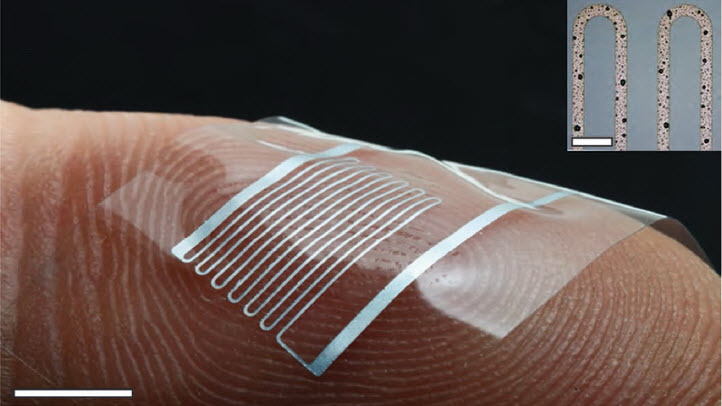Stretchable electronics that can quadruple in length
March 3, 2016

Stretchable biphasic gold–gallium thin films. Scale bar: 5 mm; Inset scale bar: 500 micrometers. (credit: Arthur Hirsch et al./Advanced Materials)
EPFL researchers have developed films with conductive tracks just several hundreds of nanometers thick that can be bent and stretched up to four times their original length. They could be used in artificial skin, connected clothing, and on-body sensors.
Instead of bring printed on a board, the tracks are almost as flexible as rubber and can be stretched up to four times their original length and in all directions a million times without cracking or interrupting their conductivity. The material could be used to make circuits that can be twisted and stretched — ideal for artificial skin on prosthetics or robotic machines.
It could also be integrated into fabric and used in connected clothing. And because it follows the shape and movements of the human body, it could be used for sensors designed to monitor particular biological functions.
The films use an alloy of gallium to achieve a liquid state at room temperature and gold to ensures the gallium remains homogeneous, preventing it from separating into droplets. The invention is described in an article published today in the journal Advanced Materials.
École polytechnique fédérale de Lausanne (EPFL) | Stretchable electronics that quadruple in length
Abstract of Intrinsically Stretchable Biphasic (Solid–Liquid) Thin Metal Films
Stretchable biphasic conductors are formed by physical vapor deposition of gallium onto an alloying metal film. The properties of the photolithography-compatible thin metal films are highlighted by low sheet resistance (0.5 Ω sq−1) and large stretchability (400%). This novel approach to deposit and pattern liquid metals enables extremely robust, multilayer and soft circuits, sensors, and actuators.